What is Gmail?The Gmail or Google Mail is a free email service introduced by Google. It allows sending and receiving mails over the Internet. We can also send an email to multiple users at a time. The Gmail site is a type of Webmail. We can access the Gmail from Web and as an application in Mobile devices. We can also use the third-party program to access the Gmail. Such programs synchronize the email content through the protocols IMAP (Internet Message Access Protocol) or POP (Post Office Protocol). Some basic details of Gmail are listed below:
The storage capacity at the time of launch was Gigabytes, which is extended upto 15 Gigabytes today. The receiving capacity of emails is 50 Megabytes per user while sending capacity is 25 Megabytes, including attachments. The exchange of emails in Gmail can include text or messages, graphics, videos, and audio. Initially, Gmail was created on April 1, 2004, and ended its testing on July 7, 2009. The storage capacity was 1 GB, which was quite a large amount offered compared to other competitors at that time. The Ajax (Asynchronous JavaScript and XML) web development techniques were early adopted by Gmail rather than other web developers. Gmail also covers 94% of the languages spoken by Internet users worldwide. We can insert the files from Google Drive in order to send larger storage files. The search interface in Gmail is similar to the Search forum on the Internet. The server of Google can automatically scan multi-purpose emails and can also filter malware and spam mails. Features of GmailThe features of Gmail are listed below:
History of Gmail
Main Categories in GmailAll the emails in our Gmail account are divided based on five categories, which are listed below: 1. Primary The primary tab includes all the important emails, like emails from our contacts. It is considered as the main Inbox of our Gmail account. It also includes some non-classified emails. We can also move any email to the primary folder. 2. Social The social tab includes all the email from social websites, such as YouTube, Facebook, etc. 3. Promotions The Promotions category contains all the emails related to marketing and promotional offers. 4. Updates The Updates category is a similar category like Social, promotions, and Primary. It includes receipts, statements, bills, confirmations, notifications, etc. 5. Forum It is a group in Gmail that allows people of a group to work together online. People with similar interests can easily collaborate. The forum was particularly created for organizations, teams, groups, etc. to communicate together. Available FoldersThe entire list of folders is visible on the left side of Gmail's Home page, as shown below: 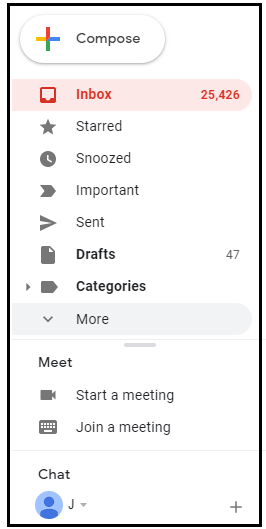
The folders available in Gmail are listed below:
PlatformsGmail has two platforms, which are discussed below: 1. WebThe basic HTML version of Gmail can run on all browsers. But the modern Ajax version is supported in a released version of web browsers, such as Microsoft Edge, Internet Explorer, Google Chrome, Safari, and Firefox. Gmail can run offline on Google Chrome. We can download it from the Web Store of Chrome. The Gmail Web page appears like the image shown below: 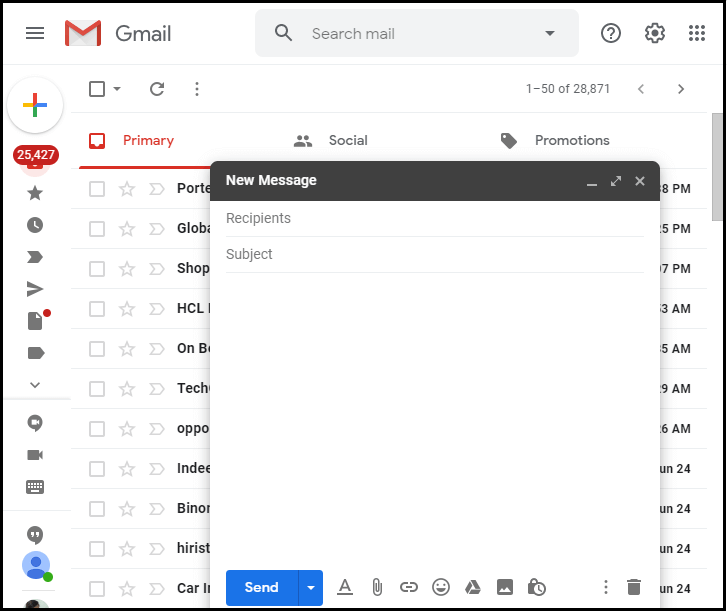
We can also access Gmail from the web browser on the mobile device. 2. Mobile ApplicationThe Gmail application is available for iOS and Android devices. Google introduced the Gmail app for Android in November 2014. It allows receiving and sending emails from non-Gmail addresses through IMAP/POP. The Gmail was further redesigned for iOS in November 2016. The update includes many features like sleeker transitions, spelling suggestions to improve search results, use of more colors, Swipe (to Archive/Delete) mail feature, Undo, Send, etc. The app was added with the security from the phishing attack in May 2017. Later, a "Smart Reply" feature was added based on Machine Intelligence followed by other languages. We can use the IMAP or POP protocols to access Gmail from the third-party programs. The Home page of Gmail app looks like the image shown below: 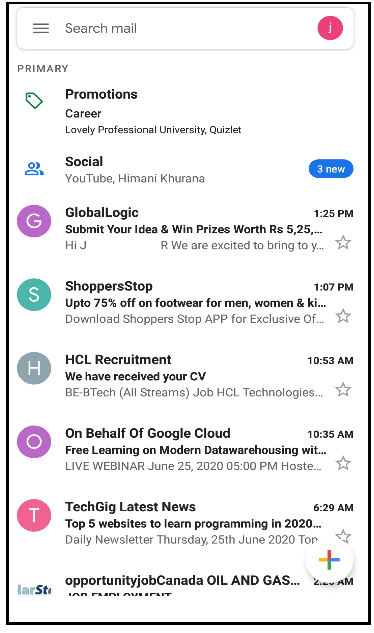
Design UpdatesSome of the major design updates by Google for Gmail are listed below:
Google Meet in GmailThe Google Meet was launched by Google in March 2017, that helps users to start a meeting online from Gmail. The video conference was limited to 30 users. The limit varies according to the subscription plans of G Suite, which includes 100 users for Basic, 150 for Business, and 250 for Enterprise plan. Due to the COVID-19 pandemic in March 2020, the access made free for consumer accounts after May 2020. The free Meet calls can have participants limit upto 100. The participant limit for G Suite users is 250, while 25 for Hangouts. We need a Google account to start a meet using Gmail. It appears on the sidebar of the Gmail Home page, as shown below: 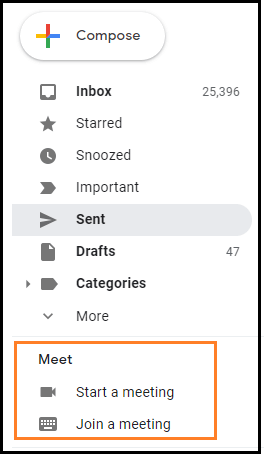
We need to click on the 'Start a meeting' to start a meeting from Gmail. The meeting contains the video and mic (for sound) option. We can ON/OFF the video or mic icon by clicking on it. We can also start the meeting using our mobile device through the Google Meet app available on the Play Store. We need to click on the 'Join Now' option to join the meeting. Relation with Google products
Security Methods in GmailThe security methods are listed below: 1. Third-Party EncryptionAccording to the Google Transparency Report, the percentage of information based on the encrypted emails is provided in transit between the third parties and Gmail. 2. LockdownsAny unknown usage or activity can cause lockdown of an account for one minute to 24 hours, such as:
3. Two-Step VerificationThe two-step verification method is provided by the Gmail for safe login. The users are required to verify their identity while login in from a new device. For example, entering a code sent to the user's registered mobile number. The verification using a security key was introduced by Google in 2004. 4. Anti-Child PornographyThe policy works in conjunction with the NCMEC (National Center for Missing and Exploited Children) to find children abuse. Google creates the database for such pornography pictures. Every image is scanned; looking for a hash (a number is given). Any doubtful image found is reported to the national authorities. GrowthThe global active users announced by Google in respective years are listed in the below table.
Gmail became the first app on Android devices to cross 1 Billion in the year 2014. The global active users today are more than 1.5 billion. Awards
Privacy termsGmail has only one privacy policy that covers all the privacy methods, which is automatic scanning of emails. Automatic Scanning of EmailsThe emails are scanned automatically by Gmail for various purposes, such as filtering malware and spam. It also includes context-sensitive related advertisements next to the emails. Privacy IssueThe major privacy issue faced by Google was the China Attack. China AttackThe cyberattack in 2010 originated from China was faced by Google. The companies with a wide business range and Chinese human rights activists were targeted. After the attack, Google has enhanced the security and privacy terms of its system. It advised users to install anti-spyware and anti-virus on the computer system. Google also warns users to be cautious of clicking any external links. Subscription PlansThe Subscription plans are available from the G Suite app. Each plan includes access to Google apps. There are three plans, which are listed below: 1. Basic PlanThe cost of the Basic plan is Rupees 210 INR / user /month. The amount can change based on the offered discount. The included applications are shown below: 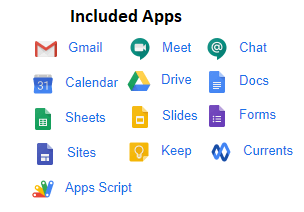
2. Business PlanThe cost of the business plan is Rupees 840 INR / user /month. The amount can change based on the offered discount. The included applications are shown below: 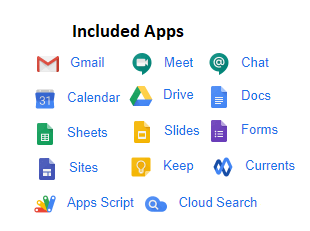
3. Enterprise PlanThe cost of the Enterprise plan is Rupees 1650 INR / user /month. The amount can change based on the offered discount. The included applications are shown below: 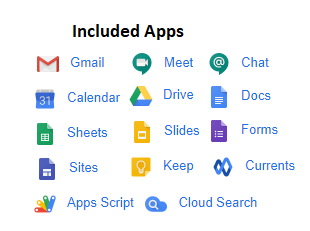
Next TopicHow to add contacts to Gmail
|
 For Videos Join Our Youtube Channel: Join Now
For Videos Join Our Youtube Channel: Join Now
Feedback
- Send your Feedback to [email protected]
Help Others, Please Share










